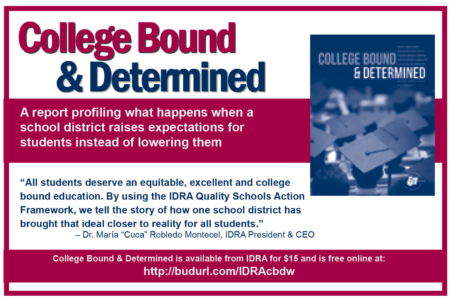• Nilka Avilés, Ed.D., and Hector Bojorquez • IDRA Newsletter • January 2018 •
 Creating a just society, based on the values and principles of human rights, requires recognizing each person’s dignity. Social justice in education recognizes that all are on equal footing and each has much to contribute.
Creating a just society, based on the values and principles of human rights, requires recognizing each person’s dignity. Social justice in education recognizes that all are on equal footing and each has much to contribute.
Yet educators daily confront the challenges of young people marginalized by unjust schooling policies and practices, along with myriad other factors that disengage them and result in poor academic performance. This litany of factors, that can be marginalizing if not done well, includes social context, curriculum, teacher pedagogy, school culture and climate, discipline, education access, policies, and health and community engagement.
Educational institutions often fail to adequately address inequities in race, class, gender, national origin and sexual orientation, all of which are intertwined with educational social constructs. Even educators themselves can be either agents or victims of institutional biases. And educators can feel powerless to affect the inequities that hurt our children.
But we are not powerless at all. In fact, educators play a powerful role in constructing approaches from a social justice perspective.
Five Principles of Social Justice
Research has identified five principles of social justice (Carlisle, Jackson & George, 2006) for equitable success of schools and students.
1. Inclusion and Equity. The school counters social inequities by creating an environment that challenges oppressive attitudes and behaviors, values multiple perspectives, and fosters community-building across social identity groups.
2. High Expectations. The school provides a diverse and challenging learning environment that supports student development, holds all students to high expectations, and empowers students of all social identities.
3. Reciprocal Community Relationships. The school recognizes its role as both a resource to, and beneficiary of, the community. It creates and sustains a mutually beneficial relationship with the community focusing on equity and social justice.
4. System-wide Approach. The schools’ mission, resource allocation structures, policies, procedures, and physical environment exemplify its commitment to creating and sustaining a socially just environment between and among various constituency groups and within all areas of the system. The school has an established protocol for examining leadership impact and other changes on mission, resource allocation, policies, etc. The equitable school is a model and research site for emulation.
5. Direct Social Justice Education and Intervention. Faculty and staff are reflective practitioners and pedagogical/content specialists willing both to teach and learn about social justice in all disciplines and teach social justice as content.
The Principles in Action
Applying these principles means ensuring that the success of all students prevails schoolwide purposefully, urgently and with commitment. It requires reflecting critically on the school environment and systems, and it requires committing purposefully to transform them.
When social justice principles permeate, marginalized communities are recognized as being full of talents and resources, not broken. This is the heart of asset-based practices and principles. As Principle 1: Inclusion and Equity implies, the school must be a safe and nurturing place for all where everyone is valued. The asset vision undergirds all social justice principles outlined above and has implications for all educational initiatives and reforms.
For example, in the curriculum, a common way schools attempt to address low student achievement in mathematics has been a sequential approach. This usually means that for students to succeed on standardized tests, they must “go back to basics.” Although seemingly logical, this approach can marginalize students perceived as needing to constantly play catch-up to get missing vital skills. But mathematics is not built on a ladder. And consistently low performance in higher math by students of color reflects this self-fulfilling prophecy.
The “back to basics” math movement has been fraught with questions as it hurts marginalized students more when teaching does not show the reasons for the basics and the connections to higher math applications driving our world. Students of color and poor students often end up merely with rudimentary skills that limit their professional and economic future.
To repeat: Students’ assets must be acknowledged and connected to the essence of educational social justice. Even if our social justice efforts identify resource gaps and funding inequities, they will fail if a deficit view of students and communities still dominates.
Putting social justice principles into practice means assessing even our most cherished educational notions. View “back to basics” mathematics instruction through a justice lens and see how that practice affects inclusion and high expectations. Eradicate the low expectations. Hold all students to high expectations and provide the academic and emotional support systems that produce student success: Principle 2: High Expectations.
 Pharr-San Juan Alamo (PSJA) ISD in the South Texas Valley models social justice principles carried out with asset-based practices (Bojorquez, 2014). To address school holding power and dropout recovery, PSJA recruits students who have dropped out to return to prepare for college, not to get a GED. Rather than follow a traditional response to dropouts with a weak curriculum, pushing them toward a GED or technology-assisted credit recovery opportunities, they are registered in dual-credit courses.
Pharr-San Juan Alamo (PSJA) ISD in the South Texas Valley models social justice principles carried out with asset-based practices (Bojorquez, 2014). To address school holding power and dropout recovery, PSJA recruits students who have dropped out to return to prepare for college, not to get a GED. Rather than follow a traditional response to dropouts with a weak curriculum, pushing them toward a GED or technology-assisted credit recovery opportunities, they are registered in dual-credit courses.
The traditional approaches of low-expectations would view these students as at-risk and only having capability for minimum requirements. By engaging in Principle 3, school districts focus their efforts on how the community addresses inequities and how, as visionary leaders, to debunk deficit practices.
PSJA implements a counter-intuitive approach based on asset based-practices. A case in point is the PSJA College, Career & Technology Academy (CCTA). Here, students earn college credits while they finish high school. The district flipped the conversation by supporting students who are in at-risk situations to succeed far beyond minimum requirements. The results have been remarkable. Within the first year, PSJA’s dropout numbers were reduced by 50 percent.
This System-wide Approach (Principle 4) also is an example of establishing Reciprocal Community Relationships (Principle 3) as the institution created an academy as a response to a need in the community that treated dropouts as students fully capable of having a college-going future. PSJA’s CCTA involves teachers, leadership teams and central office administration in regular learning communities. Together, they address social justice issues in education and the community and they co-create interventions with students. This practice has led to deeper involvement in other specialized programs in the district, such as the Sotomayor High School for teen parents and parent engagement in social justice issues in the colonias.
To address Principle 5: Direct Social Justice Education and Intervention, the faculty of these schools engages in reflective communication and staff development on their content and pedagogical practices. They examine, critically and honestly, their own racial and class attitudes for implicit biases and affirmatively counteract any inequities (Hackman, 2005).
Social justice principles in education get positive results when carried out through asset-based practices. These are not pipe dreams, but tangible realities. Transformation and progress come by addressing social justice issues in education by discarding views of our students as broken by economic and social injustices, but rather full of potential, promise and brainpower. And educators co-create a new reality where their work has deeper meaning and success.
Resources
Bojorquez, H. (2014). College Bound and Determined (San Antonio, Texas: Intercultural Development Research Association).
Carlisle, L.R., Jackson, B., & George, B. (2006). “Principles of Social Justice Education: The Social Justice Education in Schools Project,” Equity & Excellence in Education, 39 (1), 55-64.
Hackman, H.W. (2005). “Five Essential Components for Social Justice Education,” Equity & Excellence in Education, 38, 103-109.
Murakami-Ramalho, E., & Pankake, A. (Eds). (2012). Educational Leaders Encouraging the Intellectual and Professional Capacity of Others: A Social Justice Agenda (Charlotte, N.C.: Information Age Publishing, Inc.).
Nilka Avilés, Ed.D., is an IDRA senior education associate and directs the IDRA STAARS Leaders project. Comments and questions may be directed to her via email at nilka.aviles@idra.org. Hector Bojorquez is IDRA’s Director of Operations and co-directs IDRA’s Re-Energize project. Comments and questions may be directed to him via email at hector.bojorquez@idra.org.
[©2018, IDRA. This article originally appeared in the January 2018 IDRA Newsletter by the Intercultural Development Research Association. Permission to reproduce this article is granted provided the article is reprinted in its entirety and proper credit is given to IDRA and the author.]


